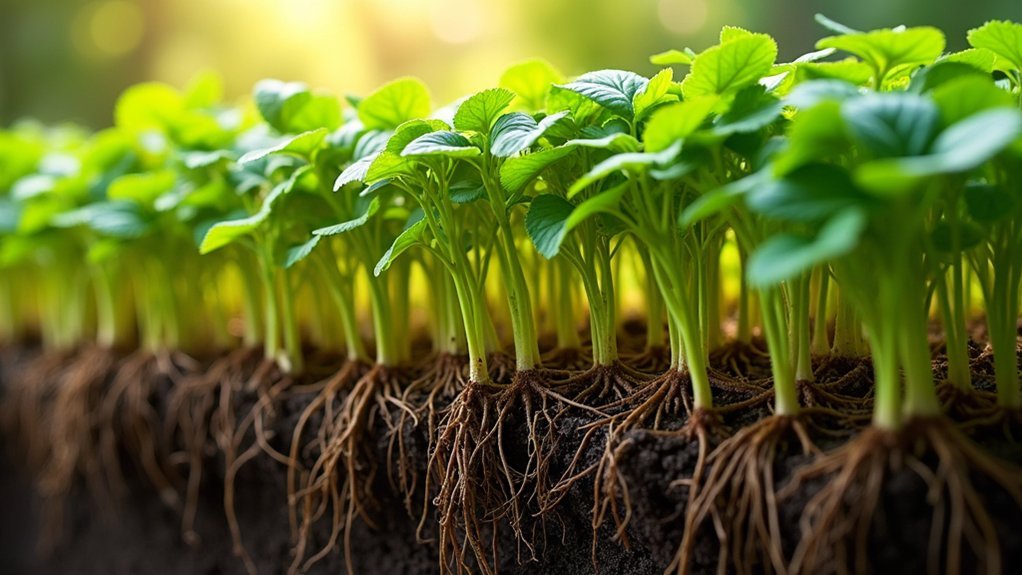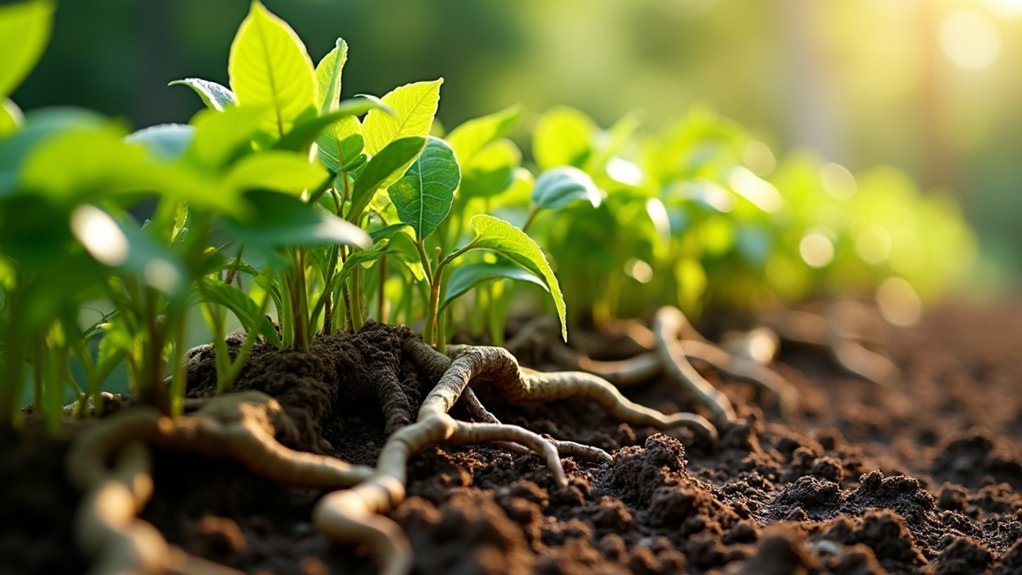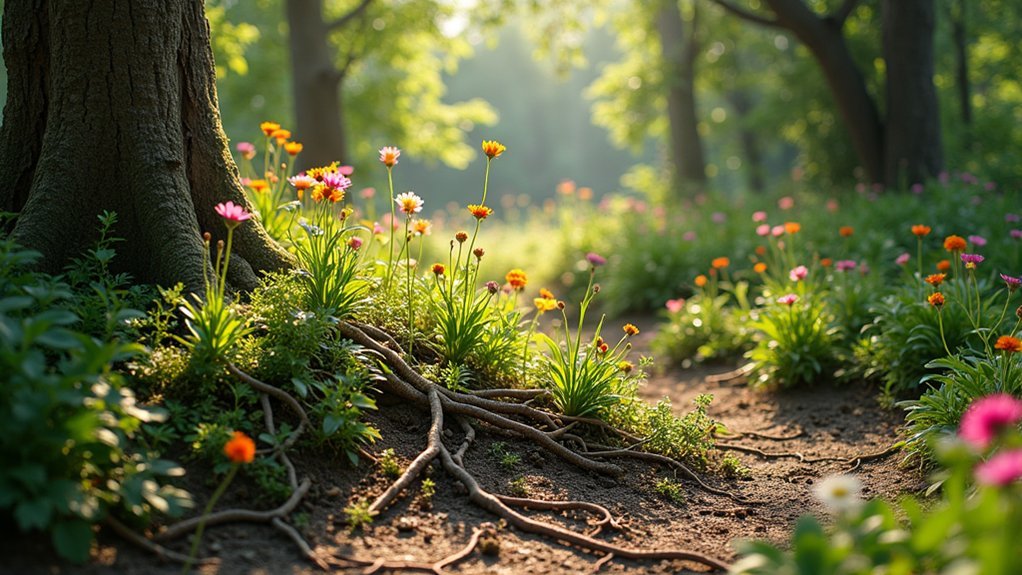Root division creates living fences naturally by leveraging plants’ regenerative abilities. When you divide root systems, each section retains functioning roots and energy reserves that quickly establish in new locations. These divisions, planted 4-8 inches apart, naturally graft together through inosculation, forming dense, impenetrable barriers. Unlike conventional fences, root-divided living boundaries are self-sustaining, pest-resistant, and enhance biodiversity. They require minimal maintenance while providing ecological benefits that strengthen over time as their complex root systems intertwine.
The Science Behind Root Division Propagation

When gardeners harness the power of root division, they’re tapping into plants’ remarkable regenerative abilities. Through techniques like crown separation, rhizome division, and offset propagation, you’re fundamentally activating dormant meristematic tissue that’s programmed to create new growth.
What makes this method so effective is that divided sections retain functioning root systems and stored energy reserves. Unlike cuttings, these divisions don’t need to expend precious resources forming entirely new roots. Instead, they immediately redirect hormones to wound sites, where auxins and cytokinins stimulate callus formation and new growth.
The biological genius of root division lies in preserving established systems while triggering powerful regenerative responses at precisely the right moment.
You’ll notice divided plants establish quickly because they maintain their mature root structures. This gives them superior drought tolerance and nutrient uptake compared to seedlings. Different plants require specific division approaches based on their root system types, with clumpers being easiest to separate and woody crowns requiring more care.
The pre-existing carbohydrate stores in rhizomes and tubers fuel rapid regeneration, fundamentally giving your new plants a head start.
Selecting Root-Hardy Species for Living Fence Creation
Creating a successful living fence begins with selecting species whose root systems can withstand division while establishing robust boundaries. For temperate zones, consider jujube and beech, while tropical regions benefit from tree ferns and specific palms. Mediterranean areas thrive with olive and almond trees.
Look for plants with fast growth rates and dense foliage like blackthorn or hawthorn for quick barrier formation. Careful management of these species is essential to prevent weed overgrowth and maintain the fence’s structural integrity. Species with pliable branches such as apple and linden excel in inosculation techniques, eventually forming unified structures.
For added security, choose thorny varieties like rugosa rose or berry brambles.
You’ll maximize success by combining species—this approach increases biodiversity, improves pest resistance, and guarantees year-round visual interest through varied textures and seasonal changes.
Optimal Timing for Root Division Success

When planning root division for your living fence, you’ll achieve the best results by working during the plant’s natural dormancy period in late fall or early spring.
You can further enhance success by scheduling division shortly after rainfall when soil moisture facilitates easier extraction and less transplant shock.
Timing your division to coincide with cool, overcast days will reduce moisture loss through transpiration, giving your newly divided roots the ideal conditions to establish themselves quickly. Maintenance through continuous pruning will be necessary to shape your living fence as it grows from the divided roots.
Seasonal Division Windows
The success of root division largely depends on timing, as plants respond differently to this process throughout the year.
Spring offers perfect conditions as warming soil stimulates new root growth, increasing transplant success rates. Fall provides similar benefits with warm soil and dormant top growth that supports root development before winter dormancy.
You’ll want to avoid summer divisions when possible, as high temperatures increase water loss and stress in newly divided plants.
Never divide plants during extremely wet conditions or hard freezes, as both can compromise survival rates. Dormant plants are significantly less stressed during the division process, improving their chances of thriving after replanting.
Consider your regional climate when planning divisions.
Cool-season grasses establish best in spring and fall, while many ornamental grasses prefer spring division.
Remember to adjust your timing based on your specific plants and local weather patterns for peak results.
Division During Dormancy
Although many gardeners overlook its importance, dividing plants during dormancy greatly increases transplant success rates while minimizing stress on the plant. You’ll achieve the best results when plants are fully dormant but before soil freezes—typically late fall or early spring. Allowing four to six weeks before ground freezing provides adequate time for establishment.
During dormancy, plants redirect energy to root storage, making them more resilient to division. You’re fundamentally working with roots at their strongest, with ample reserves for recovery.
| Dormancy Period | Benefits | Best Plants |
|---|---|---|
| Late Fall | High energy reserves | Deciduous shrubs |
| Early Winter | Reduced water loss | Herbaceous perennials |
| Mid-Winter | Minimal shock | Woody ornamentals |
| Early Spring | Pre-growth establishment | Grasses and sedges |
For successful divisions, use sharp tools to make clean cuts, preserve as much root tissue as possible, and guarantee adequate soil moisture during transplanting.
Post-Rain Timing Benefits
Timing your root division shortly after rainfall creates ideal conditions for transplant success and minimizes plant stress. The naturally moistened soil becomes looser, making digging easier and reducing potential root damage as you separate plants.
This moisture also helps prevent transplant shock while enhanced microbial activity accelerates nutrient breakdown for faster recovery. Dividing perennials on overcast days helps reduce water loss through transpiration and further reduces stress on newly divided plants.
For best results, aim for early fall division of summer bloomers like Gaillardia, giving them 4-6 weeks to establish before frost. Spring-flowering varieties like Aquilegia perform better with post-rain spring division.
Always avoid waterlogged conditions and summer heat that can stress exposed roots.
Before dividing, check your 7-day forecast for stable temperatures. Once transplanted, add compost and mulch immediately to retain that valuable rain-derived moisture in your new living fence sections.
Step-by-Step Root Division Techniques

Successful root division begins with proper timing and tool preparation, ensuring your plants thrive after separation. Start by exposing the root system in a doughnut-shaped excavation pattern around your donor plant. Carefully assess the crown to identify natural division points before making clean cuts with disinfected tools. Regular maintenance through consistent pruning will encourage dense growth in your living fence sections after division, similar to traditional hedge management.
| Division Stage | Key Action | Time Consideration |
|---|---|---|
| Root Exposure | Dig trench around plant | Morning hours best |
| Assessment | Find natural separation points | Take 5-10 minutes |
| Cutting | Make clean downward cuts | Use leverage, not force |
| Replanting | Transfer to prepared holes | Within 20 minutes |
Maintain 3-5 viable stems per section and replant immediately in pre-prepared holes with organic amendments. Water thoroughly after planting and apply a 2-3 inch mulch layer, avoiding direct stem contact.
Establishing Strong Foundation Systems After Division
Once your plants have been successfully divided, establishing strong foundation systems becomes essential for their long-term viability.
Select appropriate species based on your local climate—willows, oak, and dogwood adapt well to diverse conditions from semi-arid to rain forest environments.
When planting your divisions, remember the vital R.G.I.F. principle (roots go in first) and maintain proper spacing to create dense barriers over time.
Mix different species to enhance resilience against pests and varying soil conditions. For immediate barriers, consider palisade construction with closely placed plants, while hedges work best with spreading, thorny species.
Your newly divided plants will contribute considerably to soil stabilization through their developing root systems. Many species like Gliricidia sepium and Erythrina berteroana are easily propagated from large woody cuttings when establishing living fences.
Regular pruning encourages bushy growth, while tying crossing branches promotes natural grafting, creating a durable, living fence that supports local biodiversity.
Managing Growth Patterns in Divided Root Fences

You’ll achieve better results with your divided root fence by implementing strategic training techniques for young growth.
When directing new shoots, use stakes and guides to establish desired fence patterns while the roots are still pliable. Understanding animal behavior patterns can significantly improve the effectiveness of your living fence design by accounting for natural movement tendencies.
Timing your root division during dormant seasons (late fall or early spring) will increase your success rate and promote faster establishment.
Root Training Techniques
Four essential training techniques form the foundation of successful living fences created through root division.
First, select only healthy, disease-free root divisions with structural integrity to guarantee vigorous growth from the start. Handle these gently and apply root stimulators to minimize transplant shock.
Plant your divisions closely—typically 4-8 inches apart—in trenches that facilitate natural grafting (inosculation) between neighboring plants. This tight spacing creates a dense, living barrier while improving soil stability. Consider using disease-resistant fruits like dwarf apple or pear varieties that will provide both privacy and edible produce while maintaining fence integrity.
Implement strategic pruning multiple times during the growing season to stimulate lateral branching, and weave new vertical shoots horizontally to fill gaps. This weaving technique strengthens the fence structure naturally.
Finally, manage root health through proper irrigation placement, mulching to conserve moisture, and regular monitoring for pests or disease.
Seasonal Division Timing
Understanding the seasonal rhythm of plant growth cycles is critical when planning root division for living fences. Fall offers ideal conditions for fence installation, balancing moderate weather with drier soil that’s easier to work with.
You’ll achieve better results by dividing and transplanting roots during dormant phases to minimize stress. Cool-season plants recover slower in summer heat, while warm-season varieties thrive in 90-95°F temperatures. Time your divisions accordingly.
When establishing living fences, consider how paddock sizes may need seasonal adjustment based on plant productivity. Maintain appropriate stubble height for different plant types to encourage robust regrowth. For more permanent living fence lines, implement proper planning techniques that account for long-term growth and maintenance over the fence’s 25-50 year lifespan.
For cost efficiency, procure materials when seasonal demand is low.
Remember that your living fence provides not just boundary demarcation but also creates valuable wildlife habitat that changes beautifully with the seasons.
Troubleshooting Common Root Division Challenges
While establishing living fences through root division offers numerous advantages, this propagation method isn’t without significant challenges that require careful attention.
You’ll need to strategically manage root competition with adjacent crops, prevent nutrient depletion zones, and minimize canopy shading that can reduce productivity.
- Competition Management – Space plants appropriately and select compatible species to reduce resource competition between fence plants and crops.
- Labor Planning – Schedule regular pruning and maintenance to control biomass production and prevent unwanted spreading.
- Livestock Protection – Install temporary barriers around newly divided sections until established or choose thorny/unpalatable species like Osage orange or honey locust that historically provided excellent protective barriers.
- Division Technique – Guarantee each division contains sufficient root and shoot biomass, and perform divisions during dormant seasons when plants experience less stress.
Enhancing Biodiversity Through Strategic Root Management

Living fences established through root division create biological superhighways that dramatically enhance biodiversity across agricultural landscapes.
Your carefully managed root networks form wildlife corridors with Shannon Index values of H=3.5, comparable to forest understories, supporting over 253 plant species while providing shelter and stabilizing microclimates.
When you incorporate nitrogen-fixing species like honey locust, you’ll enhance mycorrhizal networks and improve soil structure through decomposed root matter.
These multispecies root guilds create niche partitioning where herbs, shrubs, and trees coexist, increasing species richness to impressive levels—up to 109 species in tropical dry forest fences.
Your living fences become ecological amplifiers through fast recolonization, carbon sequestration, and pollinator support, while fostering essential root-animal mutualisms that attract frugivores and provide habitat for beneficial insects. The practice of establishing living fences dates back to Neolithic farming communities who used them to contain livestock and protect crops from wild animals.
Economic Benefits of Root-Propagated Fence Systems
Beyond their ecological value, root-propagated fence systems provide remarkable economic advantages that translate directly to your bottom line.
You’ll experience considerably reduced maintenance costs compared to traditional fencing, while enjoying greater durability against environmental stressors.
These living boundaries offer financial benefits at multiple levels:
- Initial investment minimization – Use cuttings from existing plants rather than purchasing expensive materials
- Long-term cost reduction – Avoid replacement costs as living fences self-regenerate and strengthen over time
- Resource efficiency – Eliminate ongoing material purchases while requiring only natural rainfall
- Income diversification – Harvest additional products like fruits, biomass, or medicinal plants depending on species chosen
While establishment requires labor investment, the economic returns multiply as your living fence matures, providing sustainable value that traditional fencing simply can’t match. Living fences are uniquely resistant to termites and other wood-destroying pests that quickly damage conventional wooden fencing.
Frequently Asked Questions
How Do Living Fences Interact With Existing Utility Lines?
You’ll need to plan your living fence carefully to avoid obstructing utility lines. You can use plants to conceal utility boxes visually, but don’t impede maintenance access with dense foliage.
Can Root-Divided Fences Provide Protection Against Wildfires?
Root-divided fences can provide limited wildfire protection if you’re using fire-resistant species. They’ll create natural barriers when well-maintained and properly hydrated, but they’re not foolproof against intense fires or flying embers.
Do Living Fences Attract Unwanted Wildlife or Pests?
Living fences can attract both beneficial and unwanted wildlife. You’ll likely see some pests, but they’re typically balanced by natural predators. With proper plant selection and maintenance, you’ll minimize pest problems while supporting biodiversity.
How Do Living Fences Perform in Extreme Drought Conditions?
In extreme drought, you’ll find living fences perform well if you’ve selected drought-resistant species. They’ll maintain structure while providing windbreak effects, though you might need supplemental irrigation for younger plants during severe conditions.
Are There Legal Restrictions on Living Fence Heights in Residential Areas?
Yes, your living fence must comply with local height regulations, typically 3-4 feet in front yards and 6-8 feet for side/rear boundaries. You’ll need to check your specific municipal ordinances for exact restrictions.
In Summary
You’ve now discovered how root division naturally transforms ordinary plants into vibrant living fences. By selecting the right species, timing your divisions properly, and managing growth patterns, you’ll create boundaries that strengthen over time. Don’t forget that these natural barriers offer ecological and economic advantages conventional fencing can’t match. With patience and proper technique, you’ll enjoy a thriving, self-sustaining fence system that enhances your landscape for years to come.





Leave a Reply